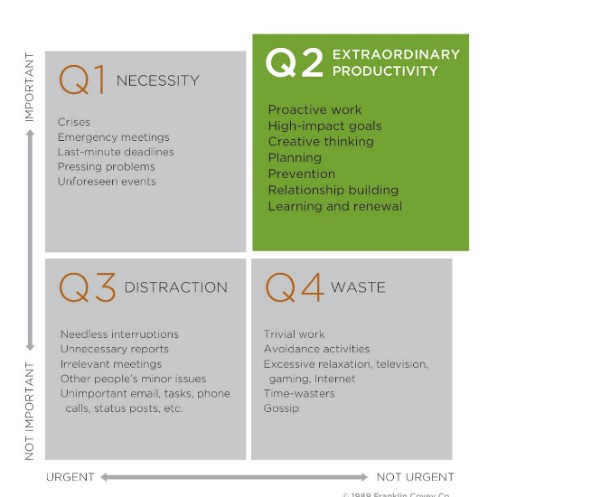Building a Q2 Culture
Acting on important tasks rather than reacting to the urgent
Devin Gilhuly, MD Katherine Morrison, MD Kerry "Nellie" O'Connor, MD Jun 7, 2022
There are many tasks and distractions that demand our attention during the work day. The average employee reports spending 40% of their time and energy on tasks that are unimportant to them; leaving only 60% of their time and energy to focus on what is important to them. Adapted from Steven McCovey’s 7 Habits of Highly Effective People, the Matrix below is a method designed to help you focus your attention and energy on what matters most to you in your workplace.
In the time matrix, tasks are divided into 4 quadrants. The y axis reflects importance of a task and the x axis reflects urgency.
Quadrant 2 (Q2) includes tasks that are important but not yet urgent. Q2 tasks are where you want to focus your time and energy – proactive work on projects that matter to you, ideas you feel passionate about, high impact goals, learning and career growth opportunities, and space for creative thinking. The return on time and energy you invest on Q2 tasks is significantly higher than the time and energy you invest. Since nothing in Q2 is urgent, you must proactively decide to spend your time on these tasks. Acting on important things rather than reacting to urgent things is essential for true productivity. Productivity isn’t just about getting things done. It’s about getting the right things done.
Quadrant 1 (Q1) includes tasks that are both important and urgent. Q1 tasks are done out of necessity, like responding to crises and emergencies. In Q1, the return of time and energy you receive is equal to the time and energy you invest. Even though you are completing important tasks, spending too much time responding to Q1 crises will leave you feeling exhausted and over time will burn you out.
Quadrant 3 (Q3) includes tasks that are urgent but not important. Q3 tasks are distractions that get in the way of focusing on what is most important to you. The return on a Q3 task is less than the time and energy you invest. Spending a large amount of time on Q3 distractions will lead to you feeling busy but unfulfilled and unaccomplished.
Quadrant 4 (Q4) includes tasks that are neither important nor urgent. Q4 activities are how you waste your time, often in response to feeling burnt out by spending too much of your time and energy on Q1 emergencies and Q3 distractions. There is no return for the time and energy you spend on Q4 activities. Spending too much time on Q4 activities will lead to you feeling lethargic, ineffective, and unfulfilled.
Reflection Questions:
- What ideas do you have on ways you could spend more of your time on Q2 activities?
- What ideas do you have on ways you can spend less time on Q3/Q4 distractions?

Adapted by Kerry O’Connor, MD, Katie Morrison, MD, and Devin Gilhuly, MD from the original presentation by Debbie Lammers, MBA, Director of Learning and Development